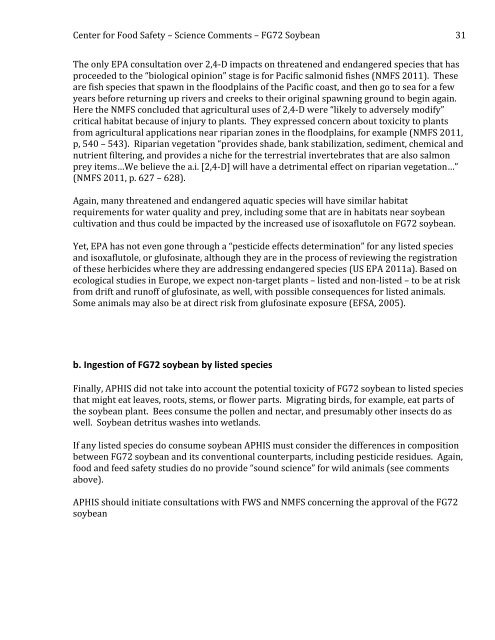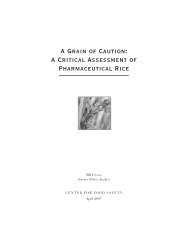a four-fold rise - Center for Food Safety
a four-fold rise - Center for Food Safety
a four-fold rise - Center for Food Safety
You also want an ePaper? Increase the reach of your titles
YUMPU automatically turns print PDFs into web optimized ePapers that Google loves.
<strong>Center</strong> <strong>for</strong> <strong>Food</strong> <strong>Safety</strong> – Science Comments – FG72 Soybean <br />
31 <br />
The only EPA consultation over 2,4-‐D impacts on threatened and endangered species that has <br />
proceeded to the “biological opinion” stage is <strong>for</strong> Pacific salmonid fishes (NMFS 2011). These <br />
are fish species that spawn in the floodplains of the Pacific coast, and then go to sea <strong>for</strong> a few <br />
years be<strong>for</strong>e returning up rivers and creeks to their original spawning ground to begin again. <br />
Here the NMFS concluded that agricultural uses of 2,4-‐D were “likely to adversely modify” <br />
critical habitat because of injury to plants. They expressed concern about toxicity to plants <br />
from agricultural applications near riparian zones in the floodplains, <strong>for</strong> example (NMFS 2011, <br />
p, 540 – 543). Riparian vegetation “provides shade, bank stabilization, sediment, chemical and <br />
nutrient filtering, and provides a niche <strong>for</strong> the terrestrial invertebrates that are also salmon <br />
prey items…We believe the a.i. [2,4-‐D] will have a detrimental effect on riparian vegetation…” <br />
(NMFS 2011, p. 627 – 628). <br />
Again, many threatened and endangered aquatic species will have similar habitat <br />
requirements <strong>for</strong> water quality and prey, including some that are in habitats near soybean <br />
cultivation and thus could be impacted by the increased use of isoxaflutole on FG72 soybean. <br />
Yet, EPA has not even gone through a “pesticide effects determination” <strong>for</strong> any listed species <br />
and isoxaflutole, or glufosinate, although they are in the process of reviewing the registration <br />
of these herbicides where they are addressing endangered species (US EPA 2011a). Based on <br />
ecological studies in Europe, we expect non-‐target plants – listed and non-‐listed – to be at risk <br />
from drift and runoff of glufosinate, as well, with possible consequences <strong>for</strong> listed animals. <br />
Some animals may also be at direct risk from glufosinate exposure (EFSA, 2005). <br />
b. Ingestion of FG72 soybean by listed species <br />
Finally, APHIS did not take into account the potential toxicity of FG72 soybean to listed species <br />
that might eat leaves, roots, stems, or flower parts. Migrating birds, <strong>for</strong> example, eat parts of <br />
the soybean plant. Bees consume the pollen and nectar, and presumably other insects do as <br />
well. Soybean detritus washes into wetlands. <br />
If any listed species do consume soybean APHIS must consider the differences in composition <br />
between FG72 soybean and its conventional counterparts, including pesticide residues. Again, <br />
food and feed safety studies do no provide “sound science” <strong>for</strong> wild animals (see comments <br />
above). <br />
APHIS should initiate consultations with FWS and NMFS concerning the approval of the FG72 <br />
soybean







